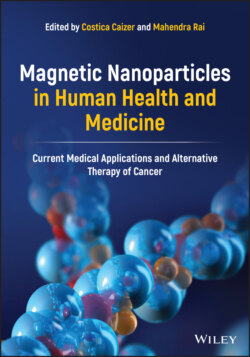Читать книгу Magnetic Nanoparticles in Human Health and Medicine - Группа авторов - Страница 48
3.3.4 Polysaccharides Coatings
ОглавлениеAnother class of molecules extensively used for the coating of magnetic nanocluster is represented by polysaccharides. These molecules are highly biocompatible and, in a certain case, of natural derivation. It is noteworthy that the first FDA‐approved formulations based on magnetic nanoparticles were obtained by assisted nucleation of magnetite, or maghemite, in the presence of dextran‐derivative (e.g. ferucarbotran and ferumoxide).
Kim et al. set a method for the preparation of nanoclusters based on the self‐assembly of magnetic nanoparticles in a modified‐dextran. First, the polysaccharide was modified with the introduction of different oleic acid amount; after that, the NPs, dispersed in the organic phase, was mixed with modified‐dextran and a nanoemulsion was inducted by ultrasonication step. After solvent evaporation, the clusters were resuspended in water. The substitution grade of dextran and the polymer amount used during clustering were selected as main parameters to govern the overall size of the nano‐object (below 100 nm) and the T2 relaxivities response. Moreover, the dextran‐modified surface properties exhibited sufficient affinity to macrophages, and therefore, the nanocluster was tested for the diagnosis, by MRI, of atherosclerotic plaques in vitro and in vivo (Kim et al. 2014).
Recently, Tran et al. modified some commercial nanoclusters, based on the assembly of single nanoparticles in a matrix of dense dextran, for a smart lateral flow application. The surface was modified with imidazole groups for the rapid conjugation with fluorescent Quantum Dots and/or receptor for cellular isolation. The purpose of this nanosystem (overall size around 200 nm) was to develop a future point‐of‐need diagnostics device able to magnetically isolate some specific targets (i.e. cells) and to exploit a smartphone camera for the detection of bright spots (Tran et al. 2019).
Park et al. reported the preparation of regular nanoclusters, based on the aggregation of hydrophobic nanoparticles in natural amphiphilic levan polysaccharides. Via an ultrasonication treatment, the nanoparticles were clustered in the polymeric matrix and therefore transferred in the aqueous phase. The size and the shape of the obtained cluster were heavily affected by the nanoparticle concentration: the cluster size increased with nanoparticles amount up to a critical threshold that avoids the formation of three‐dimensional super‐structures, favoring the bidimensional assembly. The authors demonstrated the universal method for assembly of magnetic, gold NPs, and Quantum Dots, as an individual cluster or as hybrid multifunctional systems. Concerning magnetic nanoparticles, the assembly in clusters of 200–300 nm resulted in a transverse relaxivity increase of 45% (from 65 to 95 mM−1 s−1) at 4.7 T (Park et al. 2020).
